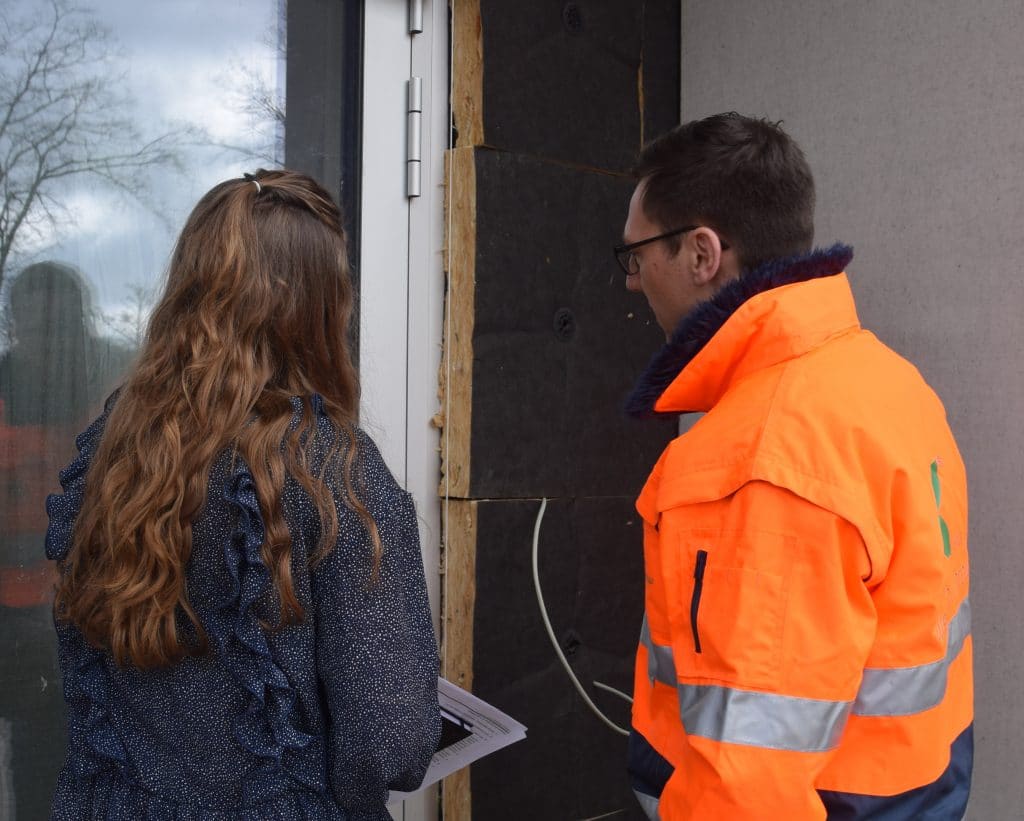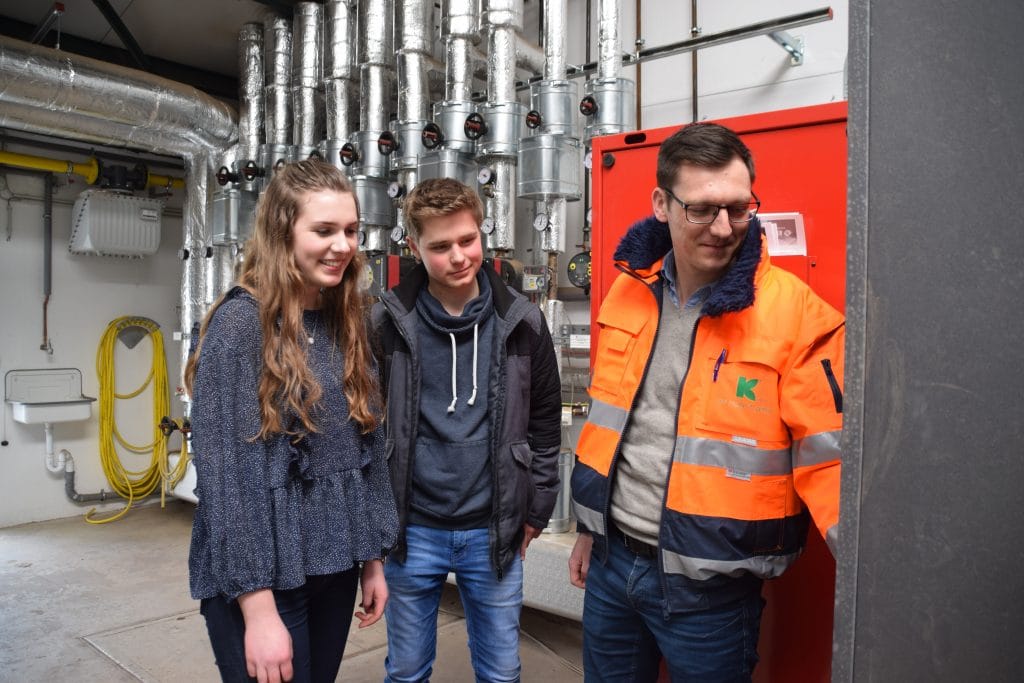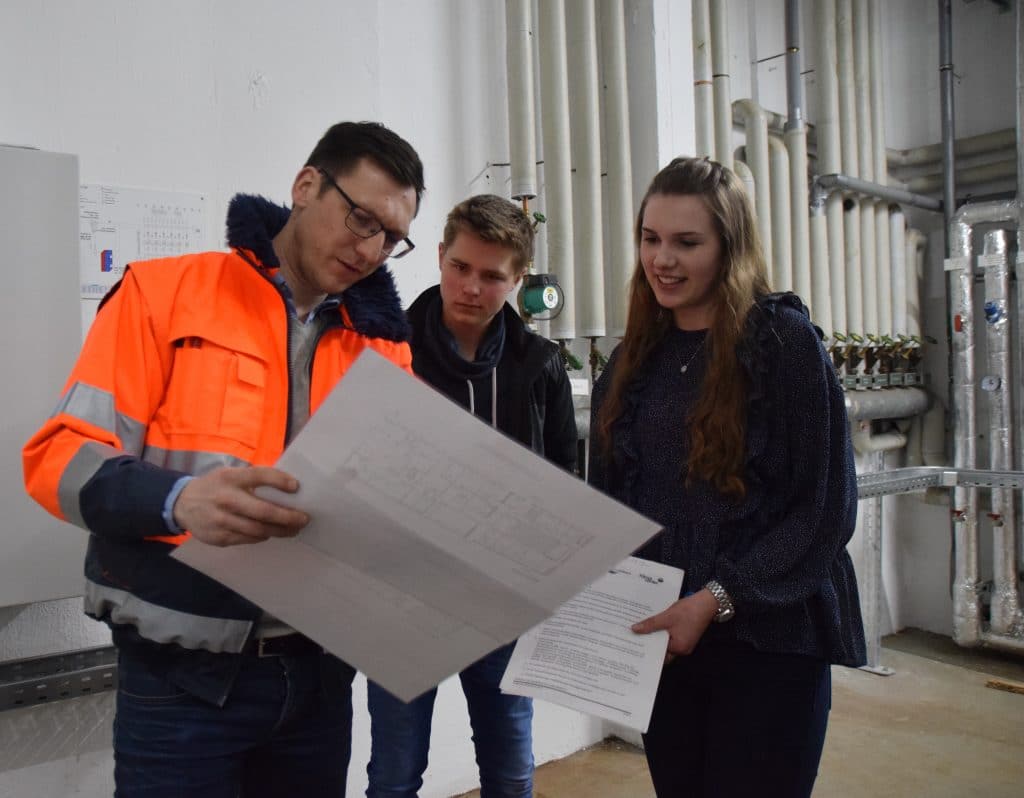Two trainees qualify as climate pilots
Climate check at the company
People who know how to save energy or use it efficiently and who pay attention to the climate as consumers and with regard to food and mobility can help to protect the climate. The earlier people become aware of this topic, the better. That is why Klasmann-Deilmann is again taking part in the campaign to have trainees qualify as climate pilots. This year’s trainees are Julia Roling and Nick Poschmann and they will conduct an in-house climate check to spotlight the company’s performance.
Armed with notebook and pencil, Julia Roling and Nick Poschmann work their way through the company building in Geeste, inspecting every nook and cranny. Christian Nienhusmeier, Project Manager for Energy Technology, helps them with their investigations and provides tips about what they should be looking for. They are now approaching our new building, the Innovation Center. “The wall cladding is made of recycled material. Do you see?” Christian Nienhusmeier points to the panelling on the façade. “You can’t tell from a distance, but it is made of wood,” he says, tapping on the material.
The building has not yet been completed, which is why the trainees can see many things that would otherwise be concealed. The project engineer puts his hand in behind the façade and pulls out the corner of a mineral wool mat which is used as insulation. “The new building is designed to meet the standard for energy-efficient buildings in the category “KfW-Effizienzhaus 55”. This means that the energy consumption is comparatively low thanks to the insulating materials, glazing and heating system.”
Click here to read our article about photovoltaics as an element of sustainability.
The three then move on to the new research greenhouse. The walls of the greenhouse have double glazing. “Again, we gave high priority to energy efficiency. That is why many things are done automatically, such as controlling the temperature, opening and closing the windows and positioning the energy screens,” explains Christian Nienhusmeier. “These screens make sure that the heat stays inside the greenhouse and simultaneously protect the plants from too strong sunlight and overheating.” Despite these effects, the experimental greenhouse has far higher energy consumption than the new head office building. “One of the reasons for this is that we have to maintain a certain temperature at all times, i.e. in both summer and winter, and not just during the daytime but also at night.” Another reason is that it has to be ventilated frequently to keep the relative humidity low.
The next stop is the workshop, which was built in the 1920s. At that time, buildings were designed completely differently and insulation was by no means standard. “This means we have to take a different approach to get the building warm. That is why we work with infrared radiant heaters,” says Christian Nienhusmeier, and explains how these devices work. Unlike other heating systems, they heat solid bodies instead of the ambient air.
Together the three investigators take a look at the heating plant and examine the light sources, almost all of which are meanwhile based on LED. It is absolutely clear: there is no shortage of material for the climate check and many aspects to consider. Both trainees have accumulated a great deal of input during the first block of climate pilot training and – in addition to handling the climate check at the company – have also decided to conduct a survey to find out how many employees cycle to work. “The percentage will probably not be very high,” predicts Nick Poschmann (trainee industrial maintenance mechanic). “Here in the country, many employees have to travel quite a long distance to work. That has to be taken into account when evaluating the figures,” says the prospective climate pilot.
Here you can read another article about climate pilots in our company.
Both trainees are already looking forward to the next training unit for climate pilots. “It was really highly informative and I learned a great deal for me personally,” comments Julia Roling. “There was also a great sense of community.” For example, all the climate pilots cooked a climate-friendly meal together. “That was quite a challenge,” says the future industrial business administrator. “To begin with, we had to agree about what to cook. When we shopped for the ingredients, we had to make sure they were climate-friendly, i.e. no meat, regional produce, no plastic packaging if possible – it all took longer than we had thought.”
They now feel well equipped to conduct the climate check. During the training course, the attendees took an in-depth look at climate problems and carbon footprints, scrutinised electricity and gas bills, performed their own calculations and visited the Climate Centre in Werlte where they learned various ways of saving energy and consequently reducing carbon emissions. They also examined different insulation materials and systems, building materials and heating plant. The two trainees make up a perfect team: “I knew quite a lot about insulation and heating, because I worked on a building site during the holidays,” says Nick Poschmann. “It was the exact opposite in my case,” adds Julia Roling. “I had already done a lot of work on climate protection at school, but insulation and heating were completely new aspects for me.”
The second block of lessons will begin in June and will evaluate the findings. We are eagerly awaiting the outcome, as this is the third time we have sent trainees to qualify as climate pilots. As a result, the trainees could split up the climate check into the different buildings. The first two candidates assessed our former administration building, the next group analysed the energy figures for the workshop and Julia and Nick are conducting the climate check for the new head office building.
Climate pilot training is a joint project run by the Energy Efficiency Agency of the Emsland district, Werlte Climate Centre and Marstall Clemenswerth Youth Education Centre.


